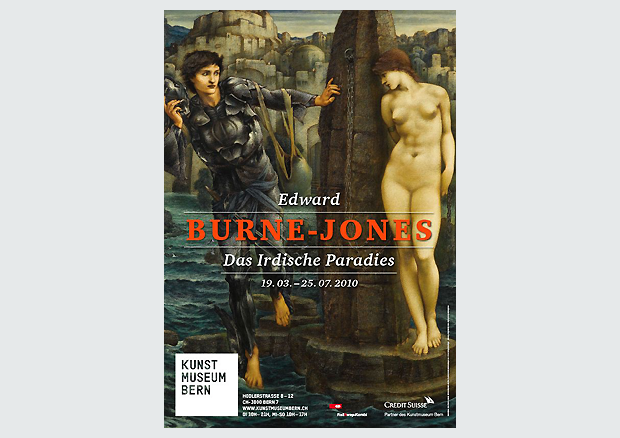Edward Burne-Jones, The Earthly Paradise, 19.3. - 25.7.2010
Escape into paradise
The Kunstmuseum Bern shows for the first time in Switzerland a large monographic exhibition by the Victorian painter and draftsman Edward Burne-Jones. Myths, legends and sagas come to life in his works. They show in an overwhelming painting technique a world full of beauty. The exhibition has been organized in collaboration with the Staatsgalerie Stuttgart and brings together around one hundred paintings and drawings, furniture and glass windows of this fascinating master of English Symbolism.
Edward Burne-Jones (1833-98), a key protagonist of the pre-Raphaelites,
is being presented in Switzerland for the first time in a large-scale
monographic exhibition. Victorian art has hitherto largely been
neglected on the European continent. Up till now it was a prerequisite
to actually go on a tour of the arts in England to become acquainted
with this epoch. The exhibition has been conceived together with the
Staatsgalerie Stuttgart and presents around one hundred paintings and
drawings, furniture and glass windows of the fascinating master of
English Symbolism Burne-Jones. Moreover, the Kunstmuseum Bern makes
reference to the Symbolism of his Swiss contemporary Ferdinand Hodler.
A discovery for fantasy fans as well
The title of the exhibition refers to one of the most important literary sources of inspiration for Burne-Jones in his narrative cycles: William Morris' very successful book The Earthly Paradise (1868). Morris, who
was Burne-Jones' close friend, companion, and business partner since
they studied together at Oxford, relates in The Earthly Paradise old
Nordic, medieval, and classical Greek sagas and legends anew using
archaic language. At the same time, the title characterizes the
painter's primary conceptual concern, as his entire oeuvre can be viewed as an alternative, idealistic concept to the prosaic and mundane impact of the industrial revolution in late Victorian times. Burne-Jones took
refuge in his art and in a world of sagas and tales peopled by knights,
magicians, dragons, and princesses, with fairies, gods, and femmes
fatales. These worlds resemble the fantasy universes of Harry Potter or The Lord of the rings by J.R.R. Tolkien. And so Burne-Jones' work today
not only fascinates the art connoisseur but also the young adventurer
and fortune seeker.
Great themes in great paintings
In his various painting series Burne-Jones, the former theology student, continually depicted people on a kind of pilgrimage. He also repeatedly makes allusion to fundamental themes such as guilt and atonement, the
search for a meaning in life, beauty and transience, fortune and
misfortune. Burne-Jones depicted his fantastic themes often in narrative cycles compromising several paintings. This mode of painting resembles
the comic-strip illustrations of today. Besides the Perseus series
further narrative cycles are presented: For example, the large-format
series of Cupid and Psyche, which he executed together with Walter
Crane, or the Pygmalion series in four paintings. Using medieval sources Burne-Jones created the Christian cycle of St. George and the Dragon,
the fairytale-like and intensely coloured Sleeping Beauty series, and
the heartrending depiction of the souls on the banks of the Styx.


